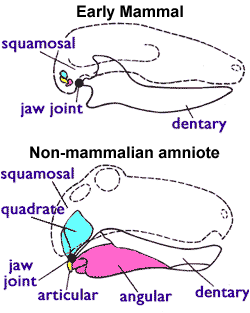Articular Extremity on:
[Wikipedia]
[Google]
[Amazon]
 The articular bone is part of the lower jaw of most vertebrates, including most
The articular bone is part of the lower jaw of most vertebrates, including most
 The articular bone is part of the lower jaw of most vertebrates, including most
The articular bone is part of the lower jaw of most vertebrates, including most jawed fish
Gnathostomata (; from Greek language, Greek: (') "jaw" + (') "mouth") are the jawed vertebrates. Gnathostome diversity comprises roughly 60,000 species, which accounts for 99% of all living vertebrates, including humans. In addition to opposi ...
, amphibians
Amphibians are four-limbed and ectothermic vertebrates of the class Amphibia. All living amphibians belong to the group Lissamphibia. They inhabit a wide variety of habitats, with most species living within terrestrial, fossorial, arbore ...
, birds
Birds are a group of warm-blooded vertebrates constituting the class Aves (), characterised by feathers, toothless beaked jaws, the laying of hard-shelled eggs, a high metabolic rate, a four-chambered heart, and a strong yet lightweigh ...
and various kinds of reptiles
Reptiles, as most commonly defined are the animals in the Class (biology), class Reptilia ( ), a paraphyletic grouping comprising all sauropsid, sauropsids except birds. Living reptiles comprise turtles, crocodilians, Squamata, squamates (lizar ...
, as well as ancestral mammals.
Anatomy
In most vertebrates, the articular bone is connected to two other lower jaw bones, the suprangular and the angular. Developmentally, it originates from the embryonic mandibular cartilage. The mostcaudal
Caudal may refer to:
Anatomy
* Caudal (anatomical term) (from Latin ''cauda''; tail), used to describe how close something is to the trailing end of an organism
* Caudal artery, the portion of the dorsal aorta of a vertebrate that passes into the ...
portion of the mandibular cartilage ossifies to form the articular bone, while the remainder of the mandibular cartilage either remains cartilaginous or disappears.
In snakes
Insnakes
Snakes are elongated, limbless, carnivorous reptiles of the suborder Serpentes . Like all other squamates, snakes are ectothermic, amniote vertebrates covered in overlapping scales. Many species of snakes have skulls with several more joi ...
, the articular, surangular, and prearticular bones have fused to form the compound bone. The mandible is suspended from the quadrate bone and articulates at this compound bone.
Function
In amphibians and reptiles
In most tetrapods, the articular bone forms the lower portion of the jaw joint. The upper jaw articulates at the quadrate bone.In mammals
In mammals, the articular bone evolves to form the malleus, one of the mammalianossicles
The ossicles (also called auditory ossicles) are three bones in either middle ear that are among the smallest bones in the human body. They serve to transmit sounds from the air to the fluid-filled labyrinth (cochlea). The absence of the auditory ...
of the middle ear. This is an apomorphy
In phylogenetics, an apomorphy (or derived trait) is a novel character or character state that has evolved from its ancestral form (or plesiomorphy). A synapomorphy is an apomorphy shared by two or more taxa and is therefore hypothesized to have ...
of the mammalian clade, and is used to determine the fossil transition to mammals. It is analogous to, but not homologous
Homology may refer to:
Sciences
Biology
*Homology (biology), any characteristic of biological organisms that is derived from a common ancestor
*Sequence homology, biological homology between DNA, RNA, or protein sequences
* Homologous chrom ...
to the articular process
The articular processes or zygapophyses (Greek ζυγον = "yoke" (because it links two vertebrae) + απο = "away" + φυσις = "process") of a vertebra are projections of the vertebra that serve the purpose of fitting with an adjacent vertebr ...
of the lower jaw.
After the loss of the quadrate-articular joint, the squamosal and dentary bones form the new jaw joint in mammals.
See also
* Evolution of mammalian auditory ossiclesReferences
Skeletal system Vertebrate anatomy {{Vertebrate-anatomy-stub